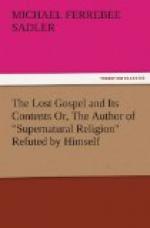[91:1] [Greek: Ton di’ hemas tou anthropous kai dia ten hemeteran soterian katelthonta ek ton ouranon, kai sarkothenta ek Pneumatos Hagiou kai Marias tes parthenou, kai enanthropesanta, k.t.l.]
[94:1] Though of course not as regards time, for all Catholics hold the Eternal Generation, that there never was a time in which the Father was not a Father; nor as regards power or extension, for whatever the Father does that the Son does also, and wherever the Father is there is the Son also.
[100:1] Eusebius, B. ii. ch. v.
[106:1] Apol. i. 14.
[107:1] The spirit of this verse, and its form of expression, are quite those of the Gospel of St. John; and it serves to form a link of union between the three Synoptic Gospels and the Fourth, and to point to the vast and weighty mass of discourses of the Lord which are not related except by St. John. Alford in loco.
[117:1] If the reader desires to see Logos doctrine expressed in philosophic terminology, he can find it in some of the extracts from Philo given in the notes of “Supernatural Religion” vol. ii. pp. 272-298. Can there be a greater contrast than that between St. John’s terse, concise, simple, enunciations and the following: [Greek: Kai ou monon phos, alla kai pantos heterou photos archetypon mallon de archetypou presbyteron kai anoteron, Logon echon paradeigmatos to men gar paradeigma ho plerestatos en autou Logos, k.t.l.]—De Somniis, i. 15, Mang. i. 634. There is no particularly advanced philosophic terminology here, and yet there is a profound difference between both the thought and wording of this sentence of Philo and St. John’s four enunciations of the Logos. Again, [Greek: Delon de hoti kai he archetypos sphragis, hon phamen einai kosmon noeton, autos an eie to archetypon paradeigma, idea ton ideon, ho Theou Logos.]—De Mundi Opificio Mang. vol. i. p. 8. “It is manifest also that the archetypal seal, which we call that world which is perceptible only to the intellect, must itself be the archetypal model, the idea of ideas, the word of God.” (Yonge’s Translation.)
[126:1] “When He came into the world He was manifested as God and man. And it is easy to perceive the man in Him when He hungers and shows exhaustion, and is weary and athirst, and withdraws in fear, and is in prayer and in grief, and sleeps on a boat’s pillow, and entreats the removal of the cup of suffering, and sweats in an agony, and is strengthened by an angel, and betrayed by a Judas, and mocked by Caiaphas, and set at naught by Herod, and scourged by Pilate, and derided by the soldiers, and nailed to the tree by the Jews, and with a cry commits His spirit to His Father, and drops His head and gives up the ghost, and has His side pierced by a spear, and is wrapped in linen and laid in a tomb, and is raised by the Father from the dead. And the Divine in Him, on the other hand, is equally manifest when He is worshipped by angels, and seen by shepherds, and waited for by Simeon, and testified of by Anna, and inquired after by wise men, and pointed out by a star, and at a marriage makes wine of water, and chides the sea when tossed by the violence of winds, and walks upon the deep, and makes one see who was blind from birth, and raises Lazarus when dead for four days, and works many wonders, and forgives sins, and grants power to His disciples.”




